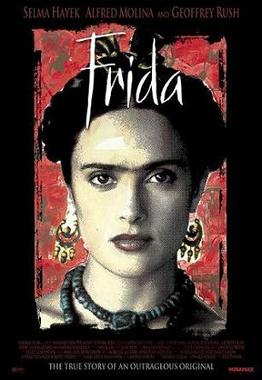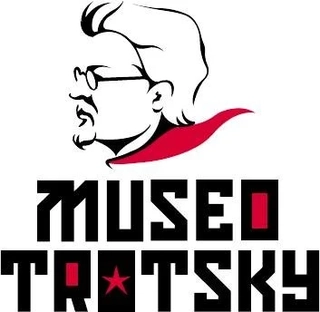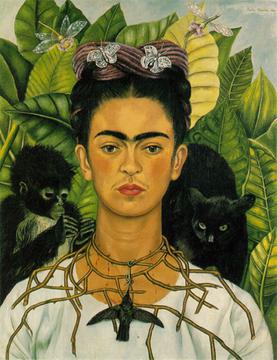
Diego Rivera, was a prominent Mexican painter. His large frescoes helped establish the mural movement in Mexican and international art.

Magdalena Carmen Frida Kahlo y Calderón was a Mexican painter known for her many portraits, self-portraits, and works inspired by the nature and artifacts of Mexico. Inspired by the country's popular culture, she employed a naïve folk art style to explore questions of identity, postcolonialism, gender, class, and race in Mexican society. Her paintings often had strong autobiographical elements and mixed realism with fantasy. In addition to belonging to the post-revolutionary Mexicayotl movement, which sought to define a Mexican identity, Kahlo has been described as a surrealist or magical realist. She is also known for painting about her experience of chronic pain.

Frida is a 2002 American biographical drama film directed by Julie Taymor which depicts the professional and private life of the surrealist Mexican artist Frida Kahlo.

Tina Modotti was an Italian American photographer, model, actor, and revolutionary political activist for the Comintern. She left her native Italy in 1913 and emigrated to the United States, where she settled in San Francisco with her father and sister. In San Francisco, Modotti worked as a seamstress, model, and theater performer and, later, moved to Los Angeles where she worked in film. She later became a photographer and essayist. In 1922 she moved to Mexico, where she became an active member of the Mexican Communist Party.
Events from the year 1937 in art.

The National Museum of Women in the Arts (NMWA), located in Washington, D.C., is "the first museum in the world solely dedicated" to championing women through the arts. NMWA was incorporated in 1981 by Wallace and Wilhelmina Holladay. Since opening in 1987, the museum has acquired a collection of more than 6,000 works by more than 1,000 artists, ranging from the 16th century to today. The collection includes works by Mary Cassatt, Alma Woodsey Thomas, Élisabeth Louise Vigée-LeBrun, and Amy Sherald. NMWA also holds the only painting by Frida Kahlo in Washington, D.C., Self-Portrait Dedicated to Leon Trotsky.

Lola Álvarez Bravo was the first Mexican female photographer and a key figure in the post-revolution Mexican renaissance. Known for her high level of skill in composition, her works were seen by her peers as fine art. She was recognized in 1964 with the Premio José Clemente Orozco, by the State of Jalisco, for her contributions to photography and her efforts to preserve the culture of Mexico. Her works are included in the permanent collections of international museums, including the Museum of Modern Art in New York City.

The Frida Kahlo Museum, also known as the Blue House for the structure's cobalt-blue walls, is a historic house museum and art museum dedicated to the life and work of Mexican artist Frida Kahlo. It is located in the Colonia del Carmen neighborhood of Coyoacán in Mexico City. The building was Kahlo's birthplace, the home where she grew up, lived with her husband Diego Rivera for a number of years, and where she later died in a room on the upper floor. In 1957, Diego Rivera donated the home and its contents to turn it into a museum in Frida's honor.

The Leon Trotsky House Museum, Trotsky Museum, or Trotsky House Museum, is a museum honoring Leon Trotsky and an organization that works to promote political asylum, located in the Coyoacán neighborhood of Mexico City. Its official name is Instituto del Derecho de Asilo - Museo Casa de León Trotsky.

Self-Portrait with Monkey is an oil on masonite painting by Mexican artist Frida Kahlo, commissioned in 1938 by A. Conger Goodyear, then president of the Museum of Modern Art in New York City. It is one of the many self-portraits painted by Kahlo for friends and patrons during her career.
Frida Still Life is a 1983 Mexican drama film about artists Frida Kahlo and Diego Rivera directed by Paul Leduc. The film was selected as the Mexican entry for the Best Foreign Language Film at the 58th Academy Awards, but was not accepted as a nominee.

The Two Fridas is an oil painting by Mexican artist Frida Kahlo. The painting was the first large-scale work done by Kahlo and is considered one of her most notable paintings. It is a double self-portrait, depicting two versions of Kahlo seated together. One is wearing a white European-style Victorian dress, while the other is wearing a traditional Tehuana dress. The painting is housed at the Museo de Arte Moderno in Mexico City.

Self-Portrait with Thorn Necklace and Hummingbird is a 1940 self-portrait by Mexican painter Frida Kahlo which also includes a black cat, a gorilla and two dragonflies. It was painted after Kahlo's divorce from Diego Rivera and the end of her affair with photographer Nickolas Muray.

The Wounded Deer is an oil painting by Mexican artist Frida Kahlo created in 1946. It is also known as The Little Deer. Through The Wounded Deer, Kahlo shares her enduring physical and emotional suffering with her audience, as she did throughout her creative oeuvre. This painting in particular was created towards the end of Kahlo's life, when her health was in decline. Kahlo combines pre-Columbian, Buddhist, and Christian symbols to express her wide spectrum of influences and beliefs.
Cristina Kahlo y Calderón (1908–1964) was the sister of artist Frida Kahlo. Frida painted a portrait of Cristina, titled Portrait of Cristina, My Sister, and Diego Rivera, Frida's husband, also portrayed Cristina Kahlo in his work. Cristina, with whom Rivera had an affair, was painted by Rivera in the nude.

Frieda and Diego Rivera is a 1931 oil painting by Mexican artist Frida Kahlo. This portrait was created two years after Frida Kahlo and Diego Rivera married, and is widely considered a wedding portrait.

The Frame is a 1938 self-portrait by Frida Kahlo. The painting features Kahlo's self-portrait in oil on a sheet of aluminum framed in glass which she purchased from a market in Oaxaca, Mexico. Although the glass frame is included as part of the painting, the flowers, birds, and other details on the frame were painted prior to being purchased by Kahlo.

Self-portrait in a Velvet Dress is a 1926 oil-on-canvas painting by Mexican artist Frida Kahlo.

Frida is a 2024 documentary film directed by Carla Gutierrez about the life of Mexican painter Frida Kahlo. As Gutierrez's directorial debut, it was first shown at the 2024 Sundance Film Festival where it won the U.S. Documentary Jonathan Oppenheim Editing Award.


















